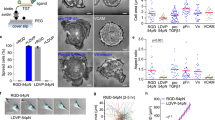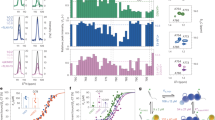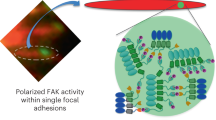Abstract
Multicellular animal development depends on integrins. These adhesion receptors link to the actin cytoskeleton, transmitting biochemical signals and force during cell migration and interactions with the extracellular matrix. Many integrin–cytoskeleton connections are formed by filamins and talin. The β7 integrin tail binds strongly to filamin and supports less migration, fibronectin matrix assembly and focal adhesion formation than either the β1D tail, which binds strongly to talin, or the β1A tail, which binds modestly to both filamin and talin. To probe the role of filamin binding, we mapped the filamin-binding site of integrin tails and identified amino acid substitutions that led to selective loss of filamin binding to the β7 tail and gain of filamin binding to the β1A tail. These changes affected cell migration and membrane protrusions but not fibronectin matrix assembly or focal adhesion formation. Thus, tight filamin binding restricts integrin-dependent cell migration by inhibiting transient membrane protrusion and cell polarization.
This is a preview of subscription content, access via your institution
Access options
Subscribe to this journal
Receive 12 print issues and online access
$209.00 per year
only $17.42 per issue
Buy this article
- Purchase on Springer Link
- Instant access to full article PDF
Prices may be subject to local taxes which are calculated during checkout







Similar content being viewed by others
References
Tamkun, J. W. et al. Structure of integrin, a glycoprotein involved in transmembrane linkage between fibronectin and actin. Cell 46, 271–282 (1986).
Huttenlocher, A., Ginsberg, M. H. & Horwitz, A. F. Modulation of cell migration by integrin-mediated cytoskeletal linkages and ligand-binding affinity. J. Cell Biol. 134, 1551–1562 (1996).
Ali, I. U. & Hynes, R. O. Effects of cytochalasin B and colchicine on attachment of a major surface protein of fibroblasts. Biochim. Biophys. Acta 471, 16–24 (1977).
Wu, C., Keivens, V. M., O'Toole, T. E., McDonald, J. A. & Ginsberg, M. H. Integrin activation and cytoskeletal interaction are essential for the assembly of a fibronectin matrix. Cell 83, 715–724 (1995).
Reszka, A. A., Hayashi, Y. & Horwitz, A. F. Identification of amino acid sequences in the integrin β1 cytoplasmic domain implicated in cytoskeletal association. J. Cell Biol. 117, 1321–1330 (1992).
Otey, C. A., Pavalko, F. M. & Burridge, K. An interaction between α actinin and the β1 integrin subunit in vitro. J. Cell Biol. 111, 721–729 (1990).
Pfaff, M., Liu, S., Erle, D. J. & Ginsberg, M. H. Integrin β cytoplasmic domains differentially bind to cytoskeletal proteins. J. Biol. Chem. 273, 6104–6109 (1998).
Horwitz, A., Duggan, K., Buck, C. A., Beckerle, M. C. & Burridge, K. Interaction of plasma membrane fibronectin receptor with talin—a transmembrane linkage. Nature 320, 531–533 (1986).
Calderwood, D. A., Shattil, S. J. & Ginsberg, M. H. Integrins and actin filaments: reciprocal regulation of cell adhesion and signaling. J. Biol. Chem. 275, 22607–22610 (2000).
Critchley, D. R. Focal adhesions—the cytoskeletal connection. Curr. Opin. Cell Biol. 12, 133–139 (2000).
Goldmann, W. H., Bremer, A., Haner, M., Aebi, U. & Isenberg, G. Native talin is a dumbbell-shaped homodimer when it interacts with actin. J. Struct. Biol. 112, 3–10 (1994).
Djinovic-Carugo, K., Young, P., Gautel, M. & Saraste, M. Structure of the α-actinin rod: molecular basis for cross-linking of actin filaments. Cell 98, 537–546 (1999).
Gorlin, J. B. et al. Human endothelial actin-binding protein (ABP-280, nonmuscle filamin): a molecular leaf spring. J. Cell Biol. 111, 1089–1105 (1990).
Liu, S., Calderwood, D. A. & Ginsberg, M. H. Integrin cytoplasmic domain-binding proteins. J. Cell Sci. 113, 3563–3571 (2000).
Belkin, A. M. et al. Muscle β1D integrin reinforces the cytoskeleton–matrix link: modulation of integrin adhesive function by alternative splicing. J. Cell Biol. 139, 1583–1595 (1997).
Sharma, C. P., Ezzell, R. M. & Arnaout, M. A. Direct interaction of filamin (ABP-280) with the β2-integrin subunit CD18. J. Immunol. 154, 3461–3470 (1995).
Sampath, R., Gallagher, P. J. & Pavalko, F. M. Cytoskeletal interactions with the leukocyte integrin β2 cytoplasmic tail. Activation-dependent regulation of associations with talin and α-actinin. J. Biol. Chem. 273, 33588–33594 (1998).
Stossel, T. P. et al. Filamins as integrators of cell mechanics and signalling. Nature Rev. Mol. Cell Biol. 2, 138–145 (2001).
van der Flier, A. & Sonnenberg, A. Structural and functional aspects of filamins. Biochim. Biophys. Acta 1538, 99–117 (2001).
Hughes, P. E. et al. Breaking the integrin hinge: a defined structural constraint regulates integrin signaling. J. Biol. Chem. 271, 6571–6574 (1996).
Wang, K., Ash, J. F. & Singer, S. J. Filamin, a new high-molecular-weight protein found in smooth muscle and non-muscle cells. Proc. Natl. Acad. Sci. USA 72, 4483–4486 (1975).
Mittal, B., Sanger, J. M. & Sanger, J. W. Binding and distribution of fluorescently labeled filamin in permeabilized and living cells. Cell Motil. Cytoskeleton 8, 345–359 (1987).
Brown, P. L. & Juliano, R. L. Selective inhibition of fibronectin-mediated cell adhesion by monoclonal antibodies to a cell-surface glycoprotein. Science 228, 1448–1451 (1985).
O'Toole, T. E. et al. Integrin cytoplasmic domains mediate inside-out signal transduction. J. Cell Biol. 124, 1047–1059 (1994).
Romzek, N. C. et al. Use of a β1 integrin-deficient human T cell to identify β1 integrin cytoplasmic domain sequences critical for integrin function. Mol. Biol. Cell 9, 2715–2727 (1998).
Lauffenburger, D. A. & Horwitz, A. F. Cell migration: a physically integrated molecular process. Cell 84, 359–369 (1996).
Bashaw, G. J., Kidd, T., Murray, D., Pawson, T. & Goodman, C. S. Repulsive axon guidance: Abelson and Enabled play opposing roles downstream of the Roundabout receptor. Cell 101, 703–715 (2000).
Bear, J. E. et al. Negative regulation of fibroblast motility by Ena/VASP proteins. Cell 101, 717–728 (2000).
Marti, A. et al. Actin-binding protein-280 binds the stress-activated protein kinase (SAPK) activator SEK-1 and is required for tumor necrosis factor-α activation of SAPK in melanoma cells. J. Biol. Chem. 272, 2620–2628 (1997).
Bellanger, J. M. et al. The Rac1- and RhoG-specific GEF domain of trio targets filamin to remodel cytoskeletal actin. Nature Cell Biol. 2, 888–892 (2000).
Ohta, Y., Suzuki, N., Nakamura, S., Hartwig, J. H. & Stossel, T. P. The small GTPase RalA targets filamin to induce filopodia. Proc. Natl. Acad. Sci. USA 96, 2122–2128 (1999).
Cunningham, C. C. et al. Actin-binding protein requirement for cortical stability and efficient locomotion. Science 255, 325–327 (1992).
Fox, J. W. et al. Mutations in filamin 1 prevent migration of cerebral cortical neurons in human periventricular heterotopia. Neuron 21, 1315–1325 (1998).
Meyer, S. C., Sanan, D. A. & Fox, J. E. Role of actin-binding protein in insertion of adhesion receptors into the membrane. J. Biol. Chem. 273, 3013–3020 (1998).
Rost, B. PHD: predicting one-dimensional protein structure by profile-based neural networks. Methods Enzymol. 266, 525–539 (1996).
Harbury, P. B., Zhang, T., Kim, P. S. & Alber, T. A switch between two-, three-, and four-stranded coiled coils in GCN4 leucine zipper mutants. Science 262, 1401–1407 (1993).
Ylanne, J. et al. Distinct functions of integrin α and β subunit cytoplasmic domains in cell spreading and formation of focal adhesions. J. Cell Biol. 122, 223–233 (1993).
Greenwood, J. A., Theibert, A. B., Prestwich, G. D. & Murphy-Ullrich, J. E. Restructuring of focal adhesion plaques by PI 3-kinase: regulation by PtdIns (3,4,5)-p3 binding to α-actinin. J. Cell Biol. 150, 627–642 (2000).
Loo, D. T., Kanner, S. B. & Aruffo, A. Filamin binds to the cytoplasmic domain of the β1-integrin. Identification of amino acids responsible for this interaction. J. Biol. Chem. 273, 23304–23312 (1998).
Mulrooney, J., Foley, K., Vineberg, S., Barreuther, M. & Grabel, L. Phosphorylation of the β1 integrin cytoplasmic domain: toward an understanding of function and mechanism. Exp. Cell Res. 258, 332–341 (2000).
Glogauer, M. et al. The role of actin-binding protein 280 in integrin-dependent mechanoprotection. J. Biol. Chem. 273, 1689–1698 (1998).
Der Ven, P. F. et al. Indications for a novel muscular dystrophy pathway. γ-Filamin, the muscle-specific filamin isoform, interacts with myotilin. J. Cell Biol. 151, 235–248 (2000).
Kiosses, W. B., Shattil, S. J., Pampori, N. & Schwartz, M. A. Rac recruits high-affinity integrin αVβ3 to lamellipodia in endothelial cell migration. Nature Cell Biol. 3, 316–320 (2001).
Rose, D. M., Cardarelli, P. M., Cobb, R. R. & Ginsberg, M. H. Soluble VCAM-1 binding to α4 integrins is cell-type specific and activation dependent and is disrupted during apoptosis in T cells. Blood 95, 602–609 (2000).
Hughes, P. E. et al. Suppression of integrin activation: a novel function of a Ras/Raf-initiated MAP kinase pathway. Cell 88, 521–530 (1997).
Liu, S. et al. Binding of paxillin to α4 integrins modifies integrin-dependent biological responses. Nature 402, 676–681 (1999).
Calderwood, D. A. et al. The talin head domain binds to integrin β subunit cytoplasmic tails and regulates integrin activation. J. Biol. Chem. 274, 28071–28074 (1999).
Kiosses, W. B., Daniels, R. H., Otey, C., Bokoch, G. M. & Schwartz, M. A. A role for p21-activated kinase in endothelial cell migration. J. Cell Biol. 147, 831–844 (1999).
Cox, E. A., Sastry, S. K. & Huttenlocher, A. Integrin-mediated adhesion regulates cell polarity and membrane protrusion through the Rho family of GTPases. Mol. Biol. Cell 12, 265–277 (2001).
Sechler, J., Takada, Y. & Schwarzbauer, J. Altered rate of fibronectin matrix assembly by deletion of the first type III repeats. J. Cell Biol. 134, 573–583 (1996).
Acknowledgements
This work was supported by grants from the National Institutes of Health and The Susan G. Komen Breast Cancer Foundation. D.M.R. was supported by an advanced postdoctoral fellowship from The Juvenile Diabetes Foundation International. D.G.W was supported by a postdoctoral grant from The Arthritis Foundation. We thank X.-T. Nguyen and J. Byrnes for technical assistance.
Author information
Authors and Affiliations
Corresponding author
Supplementary information
Supplementary figures
Figure S1 The β1A, β1D and β7 chimeric integrins are expressed at similar levels and mediate comparable levels of cell adhesion. (PDF 297 kb)
Figure S2 Chimeric αIIbβ3 integrins in which the β3 tail was replaced with the β1A, β1A(V36,40I) or β7(I36,40V) tail are expressed at similar levels and mediate comparable levels of cell adhesion.
Figure S3 Expression of α4β1 on Jurkat cell lines.
Rights and permissions
About this article
Cite this article
Calderwood, D., Huttenlocher, A., Kiosses, W. et al. Increased filamin binding to β-integrin cytoplasmic domains inhibits cell migration. Nat Cell Biol 3, 1060–1068 (2001). https://doi.org/10.1038/ncb1201-1060
Received:
Revised:
Accepted:
Published:
Issue Date:
DOI: https://doi.org/10.1038/ncb1201-1060
This article is cited by
-
Molecular basis for integrin adhesion receptor binding to p21-activated kinase 4 (PAK4)
Communications Biology (2022)
-
The structural basis of β2 integrin intra-cellular multi-protein complexes
Biophysical Reviews (2022)
-
Prune belly syndrome in surviving males can be caused by Hemizygous missense mutations in the X-linked Filamin A gene
BMC Medical Genetics (2020)
-
Talin and Kindlin as Integrin-Activating Proteins: Focus on the Heart
Pediatric Cardiology (2019)
-
NMR Structure, Dynamics and Interactions of the Integrin β2 Cytoplasmic Tail with Filamin Domain IgFLNa21
Scientific Reports (2018)



